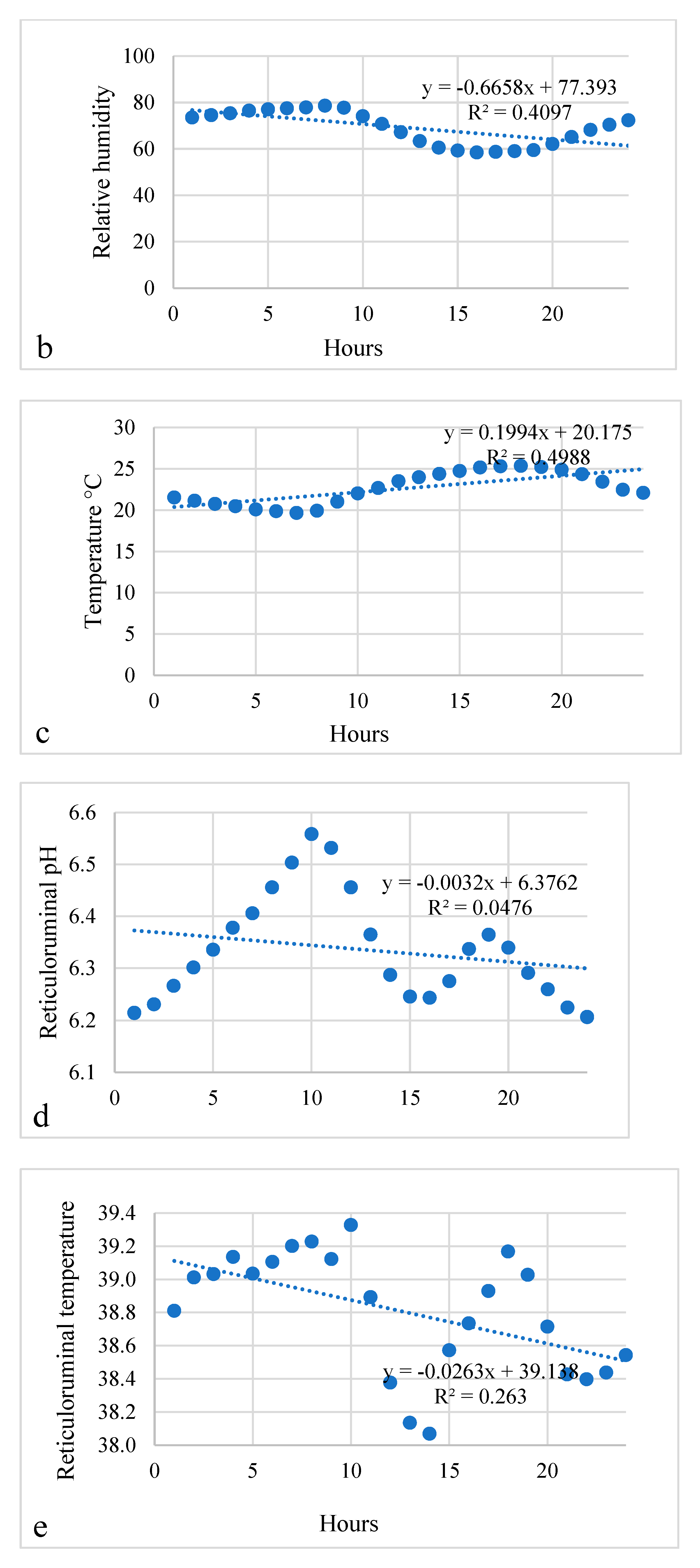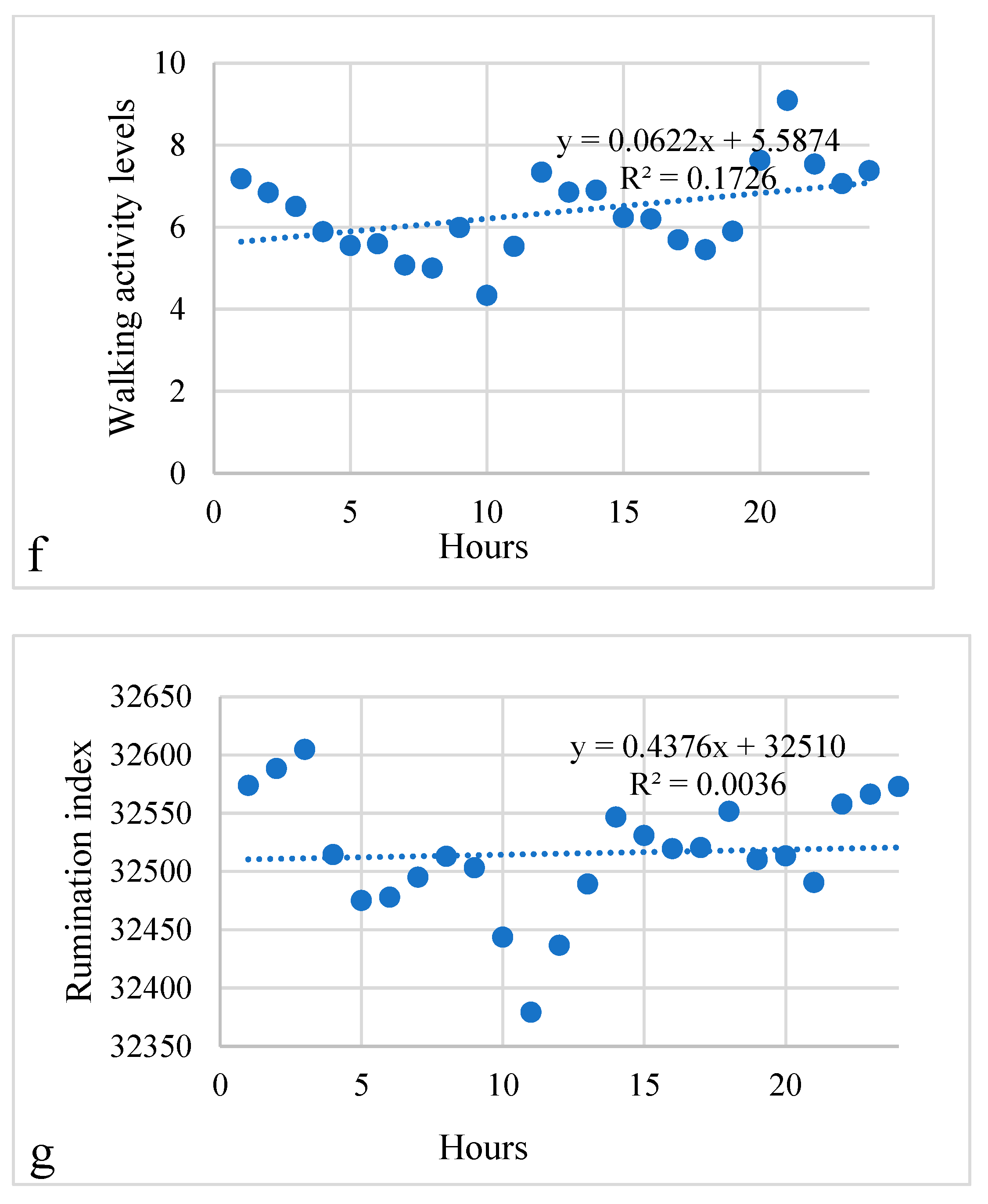Use of Innovative Tools for the Detection of the Impact of Heat Stress on Reticulorumen Parameters and Cow Walking Activity Levels
Abstract
Simple Summary
Abstract
1. Introduction
2. Materials and Methods
2.1. Animals, Housing, and Experimental Design
2.2. Measurements
Duration of Measurements
2.3. Data Analysis and Statistics
3. Results
4. Discussion
5. Conclusions
Author Contributions
Funding
Institutional Review Board Statement
Informed Consent Statement
Data Availability Statement
Conflicts of Interest
References
- Gupta, S.; Sharma, A.; Joy, A.; Dunshea, F.R.; Chauhan, S.S. The Impact of Heat Stress on Immune Status of Dairy Cattle and Strategies to Ameliorate the Negative Effects. Animals 2023, 13, 107. [Google Scholar] [CrossRef]
- Hoffmann, G.; Herbut, P.; Pinto, S.; Heinicke, J.; Kuhla, B.; Amon, T. Animal-Related, Non-Invasive Indicators for Determining Heat Stress in Dairy Cows. Biosyst. Eng. 2020, 199, 83–96. [Google Scholar] [CrossRef]
- Solomon, S.; Intergovernmental Panel on Climate Change (Eds.) Climate Change 2007: The Physical Science Basis: Contribution of Working Group I to the Fourth Assessment Report of the Intergovernmental Panel on Climate Change; Cambridge University Press: Cambridge, UK; New York, NY, USA, 2007; ISBN 978-0-521-88009-1. [Google Scholar]
- Yousaf, A.; Sarfaraz, I.; Zafar, M.A.; Abbas, R.Z.; Hussain, A.; Manzoor, A. Effect of Treatment with Tri-Sodium Citrate Alone and in Combination with Levamisole HCL on Total Milk Bacterial Count in Dairy Buffalo Suffering from Sub-Clinical Mastitis. Rev. Vet. 2010, 21, 187–189. [Google Scholar]
- Vale, W.G. Effects of Environment on Buffalo Reproduction. Ital. J. Anim. Sci. 2007, 6, 130–142. [Google Scholar] [CrossRef]
- Jo, J.-H.; Nejad, J.G.; Lee, J.-S.; Lee, H.-G. Evaluation of Heat Stress Effects in Different Geographical Areas on Milk and Rumen Characteristics in Holstein Dairy Cows Using Robot Milking and Rumen Sensors: A Survey in South Korea. Animals 2022, 12, 2398. [Google Scholar] [CrossRef]
- Rutten, C.J.; Velthuis, A.G.J.; Steeneveld, W.; Hogeveen, H. Invited Review: Sensors to Support Health Management on Dairy Farms. J. Dairy Sci. 2013, 96, 1928–1952. [Google Scholar] [CrossRef]
- Stone, A.E.; Jones, B.W.; Becker, C.A.; Bewley, J.M. Influence of Breed, Milk Yield, and Temperature-Humidity Index on Dairy Cow Lying Time, Neck Activity, Reticulorumen Temperature, and Rumination Behavior. J. Dairy Sci. 2017, 100, 2395–2403. [Google Scholar] [CrossRef]
- Levit, H.; Pinto, S.; Amon, T.; Gershon, E.; Kleinjan-Elazary, A.; Bloch, V.; Meir, Y.B.; Portnik, Y.; Jacoby, S.; Arnin, A.; et al. Dynamic Cooling Strategy Based on Individual Animal Response Mitigated Heat Stress in Dairy Cows. Animal 2021, 15, 100093. [Google Scholar] [CrossRef]
- Ammer, S.; Lambertz, C.; Gauly, M. Comparison of Different Measuring Methods for Body Temperature in Lactating Cows under Different Climatic Conditions. J. Dairy Res. 2016, 83, 165–172. [Google Scholar] [CrossRef]
- Liang, D.; Wood, C.L.; McQuerry, K.J.; Ray, D.L.; Clark, J.D.; Bewley, J.M. Influence of Breed, Milk Production, Season, and Ambient Temperature on Dairy Cow Reticulorumen Temperature. J. Dairy Sci. 2013, 96, 5072–5081. [Google Scholar] [CrossRef]
- Polsky, L.B.; Madureira, A.M.L.; Filho, E.L.D.; Soriano, S.; Sica, A.F.; Vasconcelos, J.L.M.; Cerri, R.L.A. Association between Ambient Temperature and Humidity, Vaginal Temperature, and Automatic Activity Monitoring on Induced Estrus in Lactating Cows. J. Dairy Sci. 2017, 100, 8590–8601. [Google Scholar] [CrossRef] [PubMed]
- Hut, P.R.; Scheurwater, J.; Nielen, M.; van den Broek, J.; Hostens, M.M. Heat Stress in a Temperate Climate Leads to Adapted Sensor-Based Behavioral Patterns of Dairy Cows. J. Dairy Sci. 2022, 105, 6909–6922. [Google Scholar] [CrossRef] [PubMed]
- Sammad, A.; Wang, Y.J.; Umer, S.; Lirong, H.; Khan, I.; Khan, A.; Ahmad, B.; Wang, Y. Nutritional Physiology and Biochemistry of Dairy Cattle under the Influence of Heat Stress: Consequences and Opportunities. Animals 2020, 10, 793. [Google Scholar] [CrossRef] [PubMed]
- Gantner, V.; Mijić, P.; Kuterovac, K.; Solić, D.; Gantner, R. Temperature-Humidity Index Values and Their Significance on the Daily Production of Dairy Cattle. Mljekarstvo Časopis Za Unaprjedjenje Proizv. Prerade Mlijeka 2011, 61, 56–63. [Google Scholar]
- Moretti, R.; Biffani, S.; Chessa, S.; Bozzi, R. Heat Stress Effects on Holstein Dairy Cows’ Rumination. Animal 2017, 11, 2320–2325. [Google Scholar] [CrossRef]
- Ramón-Moragues, A.; Carulla, P.; Mínguez, C.; Villagrá, A.; Estellés, F. Dairy Cows Activity under Heat Stress: A Case Study in Spain. Animals 2021, 11, 2305. [Google Scholar] [CrossRef]
- Dikmen, S.; Hansen, P.J. Is the Temperature-Humidity Index the Best Indicator of Heat Stress in Lactating Dairy Cows in a Subtropical Environment? J. Dairy Sci. 2009, 92, 109–116. [Google Scholar] [CrossRef]
- Antanaitis, R.; Urbutis, M.; Juozaitienė, V.; Malašauskienė, D.; Televičius, M. Evaluation of Biomarkers of Heat Stress Using Automatic Health Monitoring System in Dairy Cows. Pol. J. Vet. Sci. 2021, 24, 253–260. [Google Scholar] [CrossRef]
- Beatty, D.T.; Barnes, A.; Taylor, E.; Maloney, S.K. Do Changes in Feed Intake or Ambient Temperature Cause Changes in Cattle Rumen Temperature Relative to Core Temperature? J. Therm. Biol. 2008, 33, 12–19. [Google Scholar] [CrossRef]
- Becker, C.A.; Collier, R.J.; Stone, A.E. Invited Review: Physiological and Behavioral Effects of Heat Stress in Dairy Cows. J. Dairy Sci. 2020, 103, 6751–6770. [Google Scholar] [CrossRef]
- Kim, K.H.; Kim, D.-H.; Oh, Y.-K.; Lee, S.-S.; Lee, H.-J.; Kim, D.-W.; Seol, Y.-J.; Kimura, N. Productivity and Energy Partition of Late Lactation Dairy Cows during Heat Exposure. Anim. Sci. J. 2010, 81, 58–62. [Google Scholar] [CrossRef]
- Kim, S.H.; Ramos, S.C.; Valencia, R.A.; Cho, Y.I.; Lee, S.S. Heat Stress: Effects on Rumen Microbes and Host Physiology, and Strategies to Alleviate the Negative Impacts on Lactating Dairy Cows. Front. Microbiol. 2022, 13, 804562. [Google Scholar] [CrossRef] [PubMed]
- Cantor, M.C.; Costa, J.H.; Bewley, J.M. Impact of Observed and Controlled Water Intake on Reticulorumen Temperature in Lactating Dairy Cattle. Animals 2018, 8, 194. [Google Scholar] [CrossRef] [PubMed]
- Krause, K.M.; Oetzel, G.R. Understanding and Preventing Subacute Ruminal Acidosis in Dairy Herds: A Review. Anim. Feed Sci. Technol. 2006, 126, 215–236. [Google Scholar] [CrossRef]
- Antanaitis, R.; Anskienė, L.; Rapaliutė, E.; Bilskis, R.; Džermeikaitė, K.; Bačėninaitė, D.; Juškienė, V.; Juška, R.; Meškinytė, E. Relationship between Reticulorumen Parameters Measured in Real Time and Methane Emission and Heat Stress Risk in Dairy Cows. Animals 2022, 12, 3257. [Google Scholar] [CrossRef]
- Kang, H.J.; Piao, M.Y.; Park, S.J.; Na, S.W.; Kim, H.J.; Baik, M. Effects of Heat Stress and Rumen-Protected Fat Supplementation on Growth Performance, Rumen Characteristics, and Blood Parameters in Growing Korean Cattle Steers. Asian-Australas. J. Anim. Sci. 2019, 32, 826. [Google Scholar] [CrossRef]
- Yadav, B.; Singh, G.; Verma, A.K.; Dutta, N.; Sejian, V. Impact of Heat Stress on Rumen Functions. Vet. World 2013, 6, 992. [Google Scholar] [CrossRef]
- Bernabucci, U.; Lacetera, N.; Baumgard, L.H.; Rhoads, R.P.; Ronchi, B.; Nardone, A. Metabolic and Hormonal Acclimation to Heat Stress in Domesticated Ruminants. Animal 2010, 4, 1167–1183. [Google Scholar] [CrossRef]
- Kadzere, C.T.; Murphy, M.R.; Silanikove, N.; Maltz, E. Heat Stress in Lactating Dairy Cows: A Review. Livest. Prod. Sci. 2002, 77, 59–91. [Google Scholar] [CrossRef]
- Fournel, S.; Ouellet, V.; Charbonneau, É. Practices for Alleviating Heat Stress of Dairy Cows in Humid Continental Climates: A Literature Review. Animals 2017, 7, 37. [Google Scholar] [CrossRef]
- Brzozowska, A.; Lukaszewicz, M.; Sender, G.; Kolasińska, D.; Oprządek, J. Locomotor Activity of Dairy Cows in Relation to Season and Lactation. Appl. Anim. Behav. Sci. 2014, 156, 6–11. [Google Scholar] [CrossRef]
- Meneses, X.C.A.; Park, R.M.; Ridge, E.E.; Daigle, C.L. Hourly Activity Patterns and Behaviour-Based Management of Feedlot Steers with and without a Cattle Brush. Appl. Anim. Behav. Sci. 2021, 236, 105241. [Google Scholar] [CrossRef]
- Provolo, G.; Riva, E. One Year Study of Lying and Standing Behaviour of Dairy Cows in a Frestall Barn in Italy. J. Agric. Eng. 2009, 40, 27–34. [Google Scholar] [CrossRef]
- Lokhorst, C.; De Mol, R.M.; Kamphuis, C. Invited Review: Big Data in Precision Dairy Farming. Animal 2019, 13, 1519–1528. [Google Scholar] [CrossRef]
- Abeni, F.; Galli, A. Monitoring Cow Activity and Rumination Time for an Early Detection of Heat Stress in Dairy Cow. Int. J. Biometeorol. 2017, 61, 417–425. [Google Scholar] [CrossRef] [PubMed]
- Davison, C.; Michie, C.; Hamilton, A.; Tachtatzis, C.; Andonovic, I.; Gilroy, M. Detecting Heat Stress in Dairy Cattle Using Neck-Mounted Activity Collars. Agriculture 2020, 10, 210. [Google Scholar] [CrossRef]



| Trait | THI Class | M | SE |
|---|---|---|---|
| Reticuloruminal pH, value | <72 | 6.34 A | 0.003 |
| ≥72 | 6.32 B | 0.003 | |
| Reticuloruminal Temperature, °C | <72 | 38.85 a | 0.012 |
| ≥72 | 38.70 b | 0.018 | |
| Activity levels, steps per hour | <72 | 5.87 A | 0.032 |
| ≥72 | 6.77 B | 0.045 | |
| Rumination index, value average | <72 | 32,938.70 A | 27.229 |
| ≥72 | 32,180.71 B | 41.365 |
Disclaimer/Publisher’s Note: The statements, opinions and data contained in all publications are solely those of the individual author(s) and contributor(s) and not of MDPI and/or the editor(s). MDPI and/or the editor(s) disclaim responsibility for any injury to people or property resulting from any ideas, methods, instructions or products referred to in the content. |
© 2023 by the authors. Licensee MDPI, Basel, Switzerland. This article is an open access article distributed under the terms and conditions of the Creative Commons Attribution (CC BY) license (https://creativecommons.org/licenses/by/4.0/).
Share and Cite
Antanaitis, R.; Džermeikaitė, K.; Šimkutė, A.; Girdauskaitė, A.; Ribelytė, I.; Anskienė, L. Use of Innovative Tools for the Detection of the Impact of Heat Stress on Reticulorumen Parameters and Cow Walking Activity Levels. Animals 2023, 13, 1852. https://doi.org/10.3390/ani13111852
Antanaitis R, Džermeikaitė K, Šimkutė A, Girdauskaitė A, Ribelytė I, Anskienė L. Use of Innovative Tools for the Detection of the Impact of Heat Stress on Reticulorumen Parameters and Cow Walking Activity Levels. Animals. 2023; 13(11):1852. https://doi.org/10.3390/ani13111852
Chicago/Turabian StyleAntanaitis, Ramūnas, Karina Džermeikaitė, Agnė Šimkutė, Akvilė Girdauskaitė, Ieva Ribelytė, and Lina Anskienė. 2023. "Use of Innovative Tools for the Detection of the Impact of Heat Stress on Reticulorumen Parameters and Cow Walking Activity Levels" Animals 13, no. 11: 1852. https://doi.org/10.3390/ani13111852
APA StyleAntanaitis, R., Džermeikaitė, K., Šimkutė, A., Girdauskaitė, A., Ribelytė, I., & Anskienė, L. (2023). Use of Innovative Tools for the Detection of the Impact of Heat Stress on Reticulorumen Parameters and Cow Walking Activity Levels. Animals, 13(11), 1852. https://doi.org/10.3390/ani13111852









